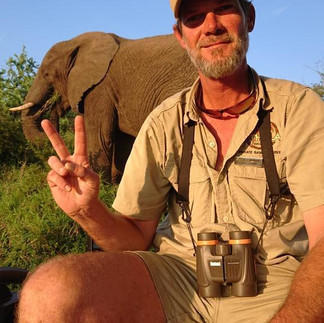World Ranger Day - What I Learned at Thula Thula
- Ayan Mehra
- Jul 31, 2023
- 3 min read
Last summer, I was lucky enough to visit Thula Thula game reserve in South Africa. During my stay I got the opportunity to spend a lot of time with some of the rangers - Muzi, Khaya and Sheldon. They taught me how to track rhinos and other animals from their paw prints and dung, how animals develop symbiotic relationships with plants, and how conservation involves taking care of orphaned wildlife in Thula Thula's rehabilitation center.
Mona & Sissi, July 2022
Tracking
One of the most important parts of tracking is animal footprints. Every animal in the bush has a unique footprint that rangers like Khaya use to track them. For example, zebras have just one large hoof, that leaves an oval indentation into the mud.

Zebra Track
Wildebeest leave heart shaped tracks in the mud, with the end of the heart pointng to the direction in which they are traveling.

Wildebeest Track
Rhino, the animal we were tracking, have only 3 toes. This helps distinguish rhino tracks from hippo or elephant tracks, as hippos and elephants have 4 toes. Rhino tracks are circular, with two toes on either side, and one toe in the direction of which they are walking.

Rhino Track
Most of the time, animal tracks are very faint, meaning that you have to keep a careful eye on the mud while driving in the jeep. Following these tracks, we can see how the animal has moved during the day.
Another important aspect of tracking is dung. Rhino dung is very special, as it can tell us a lot about the rhino. For example, after they defecate, male rhinos kick back their dung into a large area. This is to mark their territory. Their scent is spread across the area, so other male rhinos know that a dominant rhino has the space. The bull may often come back to check if any other rhino has also kicked back his dung next to his, to challenge his territory.

"Kicked Back" Male Rhino Dung
In contrast, female rhinos don’t kick back their dung, just leaving it in a pile. If the rhino is male, we can tell which direction the rhino was standing in by seeing which direction the dung was kicked back.
You can also tell how recently dung has been dropped by how wet it looks. If it is a completely dark and moist looking, it has been dropped recently. If it is a lighter shade, and seems to be completely dry, it is old dung.
Using this information, Khaya and I were able to track two of Thula Thula rhinos. First, we found Thabo, the original male rhino at the reserve.

Thabo, July 2022
Next, we managed to find Ntombi, one of the original orphaned rhinos along with Thabo.

Ntombi turning her back on us, July 2022
Animals & Plants - a Symbiotic Relationship
Along with finding these rhinos, Khaya also showed me how animal behavior can be seen in the environment. For example, some trees are bent or knocked over, because they are a common place for animals to scratch themselves. Large animals such as rhinos and elephants often wallow in mud to suffocate ticks. Then, they scratch of this mud to completely clean themselves. Some trees are even bent at a full 90-degree angle because of so much scratching. These trees are often smooth, as the bark has been worn off.

Animal Scratching Tree-Post

Bent Tree
Animal Rescue & Rehabilitation Centre
My last stop with the rangers was at the Volunteer Camp where Thula Thula runs a rescue and rehabilitation center for orphaned wildlife. The center has nurseries and medical supplies and little bomas to help young ones adapt to their natural environment with the protection of humans, since they have lost their mothers and are vulnerable in the wild.
Thula Thula Volunteer Academy (Pic 1 Main Building, Pic 2 Volunteer Tents)
Meet the Rangers
It was amazing to see how good rangers are at tracking animals, while taking care of them. I was really lucky to not only to see this in real life, but also to learn a little bit about how rangers spend their day. Big thank you to Khaya, Muzi, Sheldon and all the other rangers and for allowing me to be a part of their lives at Thula Thula last July!
L to R, Row 1: Victor, Andrew, Ashley (Anti-Poaching Unit German Shepherd),
L to R, Row 2: Muzi, Khaya, Sheldon (and Ayan)
L to R, Row 3: Khaya, Siya, Anti-Poaching Unit


























Interesting info Ayan.,enjoyed the pictures too.Thank you.